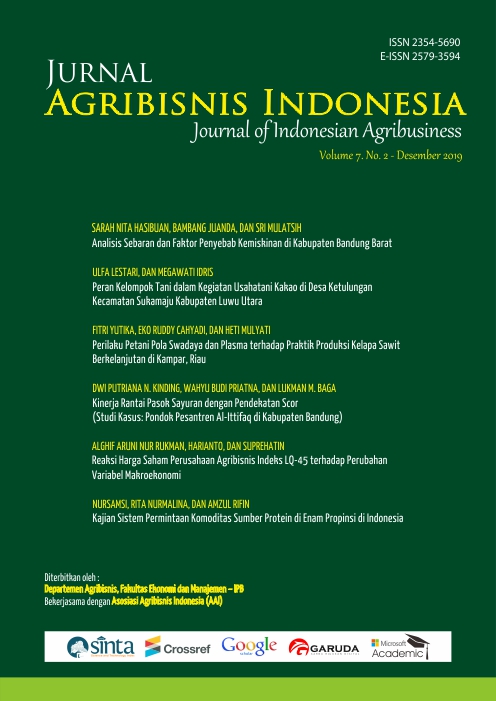PERILAKU PETANI KELAPA SAWIT POLA SWADAYA DAN POLA PLASMA TERHADAP PRAKTIK PRODUKSI KELAPA SAWIT BERKELANJUTAN DI KABUPATEN KAMPAR, RIAU
Main Article Content
Abstract
Indonesian palm oil plantation industry is confronted with sustainability issues that potentially restrict trade access in theglobal market. Smallholders are actors who have an important role in palm oil plantation sustainable development. Theory of Planned Behavior (TPB) and past behavior are used as the theoretical basis to see the influence of attitude toward sustainability, subjective norm, perceived behavioral control and past behavior toward smallholders' intention to implement sustainable palm oil production practices. This study aims to analyze differences in smallholders' intention to implement sustainable palm oil production practices between independent farmers and plasma farmers. The study sample consisted of 121 independent farmers and 121 plasma farmers wich is spread across Kampar Regency. Data collection was done by distributing questionnaires and analyzed using Structural Equation Modeling (SEM) with Partial Least Square (PLS) program. The result of this study indicates that attitude toward sustainability, subjective norm, perceived behavioral control and past behavior have a positive and significant effect on plasma farmers' intention to implement sustainable palm oil production practices, whereas subjective norm has no effect on the independent farmers' intention to implement sustainable palm oil production practices.
Downloads
Article Details
Jurnal Agribisnis Indonesia (JAI) is an Open Access Journal. The authors who publish the manuscript in this journal agree to the following terms:
Creative Commons License
JAI is licensed under a Creative Commons Attribution 4.0 International License. This permits anyone to copy, redistribute, remix, transmit, and adapt the work provided the original work and source are appropriately cited.
This means:
(1) Under the CC-BY license, authors retain ownership of the copyright for their article, but authors grant others permission to use the content of publications in Jurnal Agribisnis Indonesia in whole or in part provided that the original work is properly cited. Users (redistributors) of JAI are required to cite the original source, including the author's name, JAI as the initial source of publication, year of publication, volume number, issue, and Digital Object Identifier (DOI); (2) Authors grant JAI the right of first publication. Although authors remain the copyright owner.
References
Andoko, Agus, Widodoro. 2013. Berkebun Kelapa Sawit si Emas Cair. Jakarta (ID): PT Agro Media Pustaka.
Aikanathan S, Chenayah S, Sasekumar A. 2011. Sustainable Agriculture: A Case Study On The Palm Oil Industry. Malaysia Journal Of Science. 30(1), 66-75.
[BPS] Badan Pusat Statistik. 2015. Luas dan Produksi Perkebunan Rakyat Komoditi Sawit menurut Kecamatan Tahun 2013. [Diakses 2018 September 20]; Tersedia pada: http://kamparkab.bps.go.id/ statistictable/2015/05/17/13/luas-dan-produksi-perkebunan-rakyat-komoditi-kelapa-sawit-menurut-kecamatan-tahun-2013.
[DITJENBUN] Direktorat Jenderal Perkebunan. 2017. Statistik Perkebunan Indonesia 2015-2017: Kelapa Sawit. Kementerian Pertanian (ID). [Diakses 2018 Agustus 12]; Tersedia pada: http://ditjenbun.pertanian.go.id/tinymcpuk/gambar/file/statistik/2017/Kelapa-Sawit-2015-2017.
Dharmmesta BS. 2000. Perilaku Mencoba Beli: Sebuah Kajian Analitis Model Bagozzi Warshaw untuk Panduan Peneliti. Jurnal Ekonomi Dan Bisnis Indonesia. 12(3): 1– 27
[GAPKI] Gabungan Pengusaha Kelapa Sawit Indonesia. 2017. Sawit dan Kebijakan Industrialisasi menuju 2050. [Diakses 2018 September 10]; Tersedia pada: https://gapki.id/news/3209/sawit-dan-kebijakan-industrialisasi-sawit-menuju-2050.
Hadi S, Rifai A, Qomar N. 2009. Industri Kelapa Sawit Rakyat di Riau Membangun Kemandirian Petani. Pekanbaru (ID): UNRI Press.
Hagger MN, Chatzisarantis S, Biddle. 2002, A Meta-Analytic Review of the Theories of Reasoned Action and Planned Behavior in Physical Activity: Predictive Validity and the Contribution of Additional Variables, Journal of Sport & Exercise Psychology. 24, 3–32.
Hansson H, Ferguson R, Olofsson C, Rantamäki-Lahtinen L. 2013. Farmers' motives for diversifying their farm business–The influence of family. Journal of Rural Studies. 32, 240-250.
Menozzi D, Fioravanzi M, Donati M. 2015. Farmer’s motivation to adopt sustainable agricultural practices. Bio-based and Applied Economics. 4(2). 125-147, doi: 10.13128/BAE-14776.
Terano R, Mohamed Z, Shamsudin MN, Latif IA. 2015. Factors influencing intention to adopt sustainable agriculture practices among paddy farmers in Kada, Malaysia. Asian Journal Agriculture Research. 9(5), 268-275. doi: 10.3923/ajar.2015. 268.275
Wiratmadja I. 2017. Model Penerimaan Petani terhadap Teknologi Sistem Pertanian Organik di Kabupaten Tasikmalaya. Jurnal Manajemen Teknologi. 16(1), 81-91. doi:10.12695/jmt.2017.16.1.6.
Yazdanpanah M, Hayati D, Hochrainer-Stigler S, Zamani GH. 2014. Under-standing farmers’ intention and behavior regarding water conservation in the Mid-dle-East and North Africa: A case study in Iran. Journal of Environmental Manage¬ment. 135, 63-72.
Zeweld W, van Huylenbroeck G, Tesfay G, Speelman S. 2017. Smallholder farmers’ behavioral intentions towards sustainable agricultural practices. Journal Environment Management. 187, 71-81

